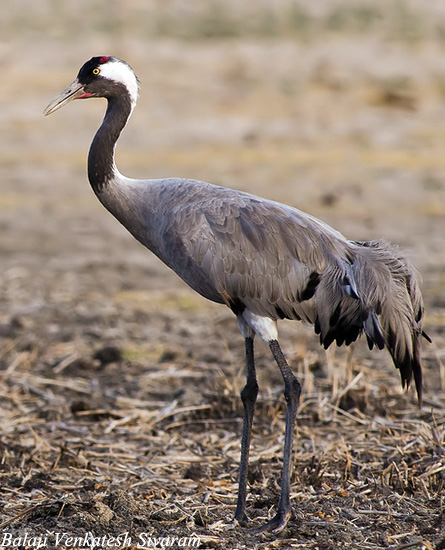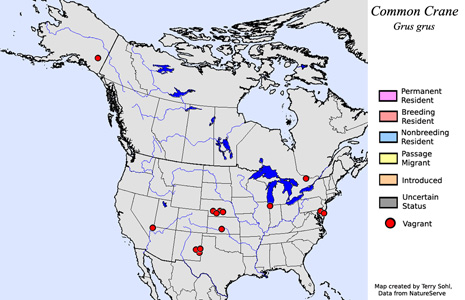Common Crane
Grus grus
| Length: 44 to 50 inches | Wingspan: 80 to 90 inches | Seasonality: Non-resident in South Dakota |
| ID Keys: Gray body, black head and neck with broad white stripe starting behind eye, red patch on crown | ||
 The
Common Crane is a bird of Eurasia and Africa, but in North America, single
birds have occasionally been found within flocks of Sandhill Cranes.
In North America the most frequent sightings have been within the great
congregations of migrating Sandhill Cranes along the Platte River in
Nebraska in March and April, or in the large number of overwintering cranes
in Bosque del Apache in New Mexico. The black head and neck and broad white
stripe starting behind the eye make it readily distinguishable from Sandhill
Cranes.
The
Common Crane is a bird of Eurasia and Africa, but in North America, single
birds have occasionally been found within flocks of Sandhill Cranes.
In North America the most frequent sightings have been within the great
congregations of migrating Sandhill Cranes along the Platte River in
Nebraska in March and April, or in the large number of overwintering cranes
in Bosque del Apache in New Mexico. The black head and neck and broad white
stripe starting behind the eye make it readily distinguishable from Sandhill
Cranes.
Habitat: In its normal breeding range, Common Cranes are found in wet meadows, forest clearings, wetlands, bogs, and grassy fields. In migration they are also often found in agricultural land.
Diet: Feeds on grains and seeds, berries, and tender shoots and roots of plants. They also will eat animal matter when available, including insects, fish, amphibians, snails, and occasionally small rodents.
Behavior: Forages by walking along the ground looking for food items. They are a very gregarious species outside of the nesting period.
Nesting: The nest is a mound of grassy vegetation built in an inaccessible areas, such as in very shallow water, in a thicket, or in a bog or wetland vegetation. Nests may be reused for many years. The female lays two eggs, with the male usually incubating during the day, and the female incubating at night. Incubation takes about 30 days. Once the eggs hatch, both parents tend to the young and feed them.
Song: Common Cranes will make both a loud trumpeting call as well as a series of low-pitched warbles.
Migration: Nearly all populations of Common Cranes are migratory. Those in Europe and western Asia move southward to northern Africa, the Middle East, Pakistan, India, and southeast Asia.
Interactive eBird map: Click here to access an interactive eBird map of Common Crane sightings
Similar Species: In North America, they are most likely to be confused with Sandhill Cranes.
Conservation Status: Populations are strong and are found over a very large geographic area. The IUCN lists the Common Crane as a species of "Least Concern".
Further Information: 1) Audubon Guide - Common Crane
2) Whatbird - Common Crane
3) BirdLife International - Common Crane
Photo Information: Photo by Balaji Venkatesh Sivaram- December 15th, 2012 - Little Rann of Kutch, Gujarat, India - Photo licensed under Creative Commons Attribution NonCommercial ShareAlike 2.0 Generic license
| Click below for a higher-resolution map |
 |
| South Dakota Status: Non-resident in South Dakota |
Additional Common Crane Photos (coming soon!!)
